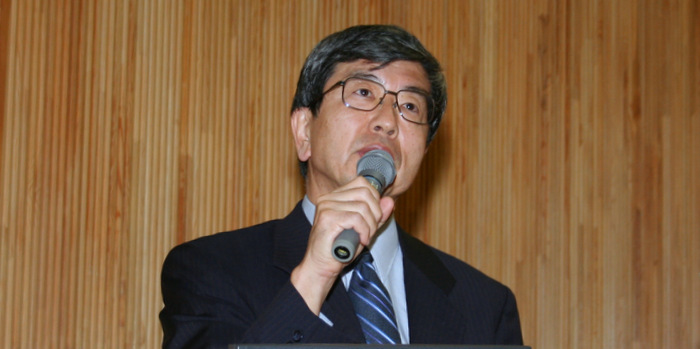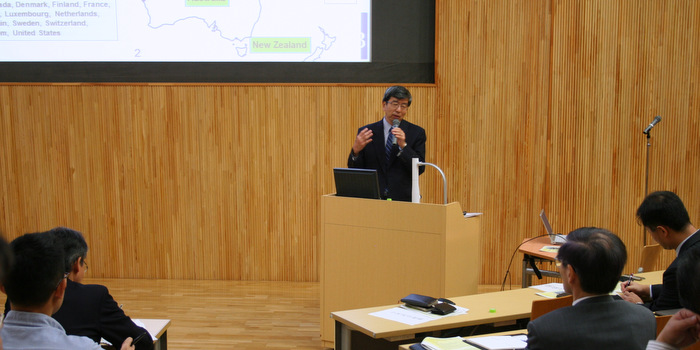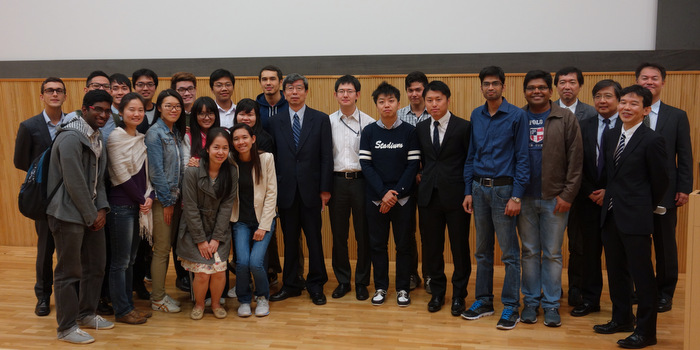The 82nd Public Policy Seminar
Asian Economic Outlook and the Role of ADB
By Mr. Takehiko Nakao, the President of the Asian Development Bank (ADB)
| Date & Time: | Thursday, October 8, 2015, 10:00-11:30 |
|---|---|
| Venue: | Fukutake Learning Theater, Hongo Campus, The University of Tokyo MAP |
Summary
The honorable speaker presented ADB's assessment of Asian economies as well as the role of ADB to address policy challenges faced by its developing member countries. The speaker also covered eight key conditions for economic development and ADB's recent reform efforts to fulfill its role. The lecture was followed by a question and answer session discussing Asian bond markets, China's growth prospects and future cooperation with partner organizations among others. The key points and messages delivered are summarized as follows.
***
ADB was founded in 1966 with strong support from countries all over Asia, following in the footsteps of other regional development banks such as the Inter-American Development Bank (IDB) in 1959 and African Development Bank (AfDB) in 1964. ADB consists of 48 regional members and 19 non-regional members. Hong Kong and Taipei maintain separate memberships to China.
Asia's economic development in very recent times is set against a backdrop of a slowing Chinese economy, decreasing commodity prices, and the creation of the Asian Infrastructure Investment Bank (AIIB). Asia has been the focus of economic discussion because of its global significance. The region is home to 53% of the world population and contributes to around one-third of global GDP.
China's economy has achieved high growth over the past 15-20 years, accompanied by modest inflation and renminbi appreciation. The growth in per capita income in China, Malaysia, the Philippines and Thailand among others has created a core of middle-income countries in Asia. Overall, Asia's growth remains strong despite the global financial crisis in 2008-2009.
Economic performance differs from country to country. Thailand growing below its potential has been due to domestic political instability. Myanmar recorded high growth after opening up to the world economy. The Philippines’ economy has started to regain its momentum with President Aquino's efforts against corruption and improving the investment climate. India maintains high growth and Prime Minister Modi's economic reforms aim to make India the fastest growing economy, surpassing China. The lack of well-connected value chains and production networks with the rest of Asia is one of the challenges for India. Economic reforms have accounted for rapid growth in Asia. Indonesia's policy shift toward market liberalization is a reflection of a convergence of ideas on economic development. Open trade and investment regimes keep economies on high growth trajectories by improving efficiency and promoting technological advancement. Thus, whilst Asia can take pride in the progress made thus far, it must continue to push forward with integration and liberalization to stimulate the next phase of economic growth.
If policies are implemented to support this growth, it is projected that Asia's share of world GDP will rise to 50% by 2050. Despite such promise, poverty eradication remains a challenge. There was over 500 million people in Asia living on less than $1.25 per day in 2011: more than half of the world's poor population.
ADB provides loans, grants, and technical assistance to developing member countries in Asia and the Pacific. Loans are financed from ordinary capital resources (OCR) and the Asian Development Fund (ADF). OCR loans are provided to middle income countries while ADF loans are given to low income countries on concessional terms. Loan approvals in 2014 totaled $10.4 billion from the OCR and $2.7 billion from the ADF.
The proposal to combine OCR and ADF balance sheets was approved in May 2015. This could enhance ADB's lending capacity by transferring the ADF equity to the OCR equity and adding leverage on it. ADF equity is not leveraged and its lending is constrained by donor contributions. The merger will boost ADB’s total annual lending and grant approvals to as high as $20 billion, 50% more than the current level. This initiative brings about a win-win situation because it increases financial support for poorer members, expands capacity for operations in middle-income countries and the private sector, and reduces the burden for ADF donors. OCR resources are used for supporting renewable energy, agriculture and transport projects among others. There is a renewed concern about food security due to population growth, climate change and water scarcity.
As expressed in an op-ed in Nikkei Asian Review dated February 5, 2015 (attached), there are eight conditions for economic development.
- Infrastructure investment
- Investment in health and education
- Macroeconomic stability
- Open trade and investment regimes, including streamlining regulatory framework and reforming state-owned enterprises
- Public governance (anti-corruption, efficiency delivering services and quality of regulations)
- Social inclusiveness (sharing development fruits)
- Vision for the future
- Political stability, security, and good relations with neighboring countries
In line with Strategy 2020, ADB's long-term strategic framework for 2008-2020, ADB plays a key role in regional cooperation and integration. Furthermore, reflecting the mid-term review of Strategy 2020 approved in April 2014, ADB also places a special emphasis on middle-income countries and lending to the private sector. As announced in September 2015, ADB aims to double climate financing for both mitigation and adaptation to $6 billion by 2020 from the current level.
ADB's continued efforts in advancing reforms include enhancing lending capacity, streamlining procurement, further delegation of authorities to resident missions, and strengthening thematic knowledge and expertise among staff. ADB created the Office of Public-Private Partnership to provide governments with independent advice on shaping public-private partnerships (PPPs). Furthermore, talent management and workforce planning is being strengthened.
ADB is committed to working closely with other organizations, including AIIB, to address the vast infrastructure needs facing Asia by using its years of experience and expertise in the region.
Prepared by David Syam Budi Bakroh (second year master's student supported by Asian Development Bank-Japan Scholarship Program)



Related Resources
-
Asian Development Bank
-
PDF, 4.00MB
-
Eight key conditions for economic development
NIKKEI ASIAN REVIEW | FEB. 9-15, 2015
PDF, 523KB
-
October 8, 2015